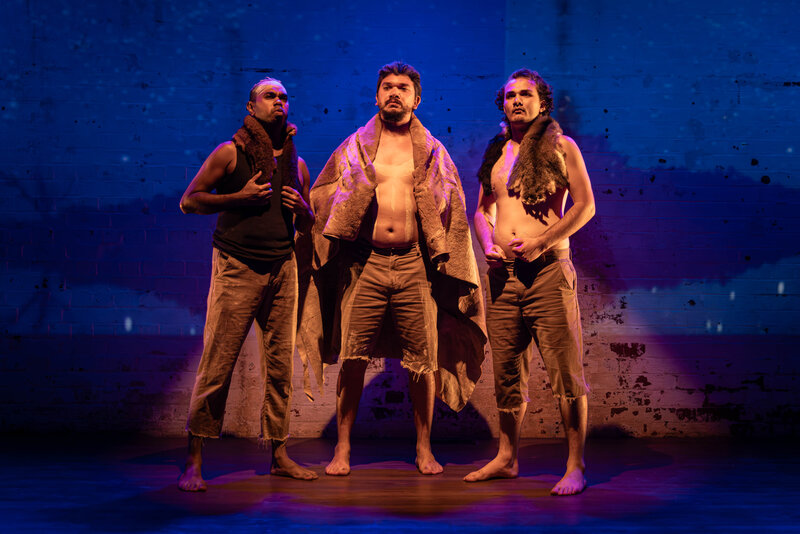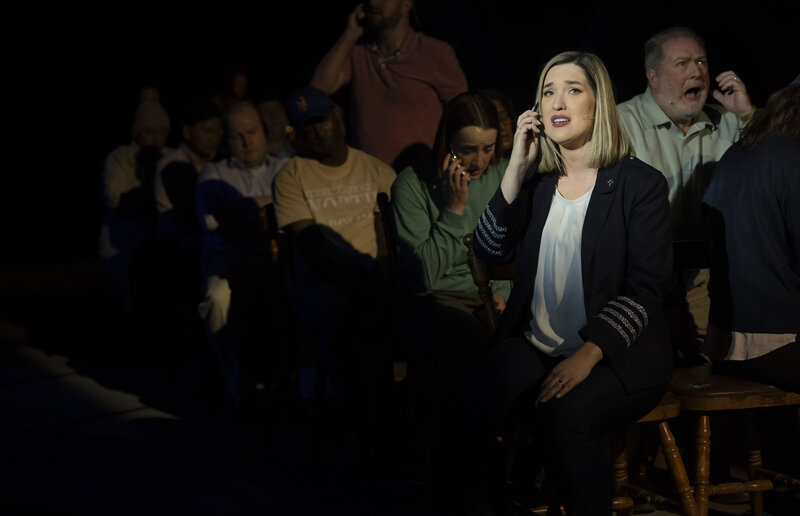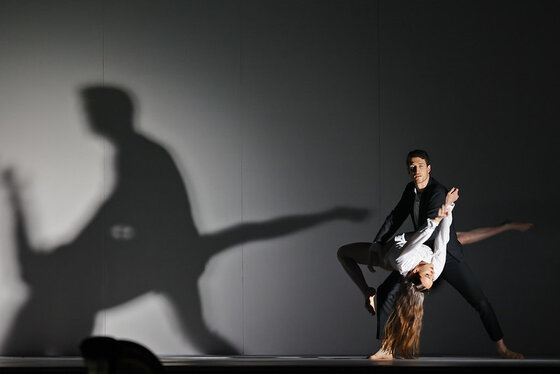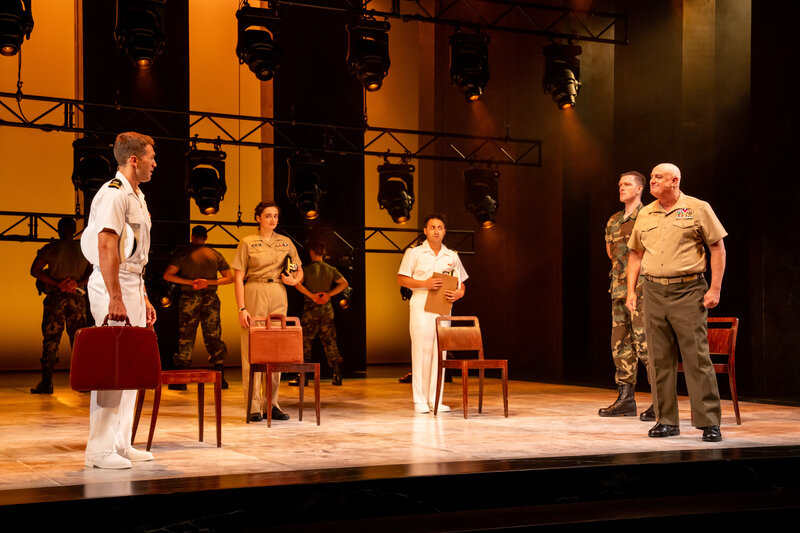Noel Coward, at the age of 25, wrote and starred in The Vortex, opening in December in 1924, which settled into a long London run. Sheridan Morley tells us in his biography of Noel Coward, A Talent to Amuse:
On the principle that success breeds other successes, once The Vortex was an established hit both Hay Fever and Fallen Angels, which had previously been turned down by every management in London, went into rapid production; by June of 1925 Noel had all three and On With the Dance (a revue) running simultaneously in the West End. [1]
Said Coward, “Success took me to her bosom like a maternal boa constrictor.” Indeed, it seems, he had a talent to amuse. The Bright Young Things of The Twenties found a crystallisation of the vast social changes initiated in the First World War in work like Coward’s and embraced it with a care-free release. Hay Fever played for 337 performances in its opening season.
 It, along with Private Lives, Fallen Angels and Blithe Spirit have been the most revived of all of Coward’s work. Hay Fever was the play that Sir Laurence Olivier selected as part of his 1964 National Theatre Company season, reviving an interest in Coward’s output and recognising it as one of the twentieth century comic classics. Coward himself directed the production, recalling the style of the period and understanding
It, along with Private Lives, Fallen Angels and Blithe Spirit have been the most revived of all of Coward’s work. Hay Fever was the play that Sir Laurence Olivier selected as part of his 1964 National Theatre Company season, reviving an interest in Coward’s output and recognising it as one of the twentieth century comic classics. Coward himself directed the production, recalling the style of the period and understanding
“the elliptical twin-level technique which he had first perfected … the technique of having a character say one thing while thinking and meaning something entirely different. [1]
As Coward says: “Small talk, a lot of small talk, with other thoughts going on behind.”
The amateur theatre has it as one of its favourites, wholly underestimating, warned Coward, the enormous difficulty of finding the right tone to keep the work afloat. The last time I saw Hay Fever, the New Theatre gave it a fair rendition.
All comedy is hard. Of all the genres to act, comedy is the hardest, because it demands, absolutely primed technical skills and a need for a ‘real’ truth – the importance of being earnest! The kind of comedy that Noel Coward excelled in is what is known as ‘artificial comedy’, where the chief concern of the playwright is the external manners of a given period which, though superficial, do deeply affect behaviour. It needs the lightest touch at the most detached point of view, for they deal with externals. There are technically two kinds of comedy: one that lies in the witty line, the other that is in the situation or the characters. For the first, it can be, that only clear delivery of the author’s words are necessary (hmmm, Kevin?). For the second, to ensure laughter it is essential to tell the truth, and in comedy it demands an exaggerate, a doubling, perhaps, of the amount of belief than you need for drama. It requires you to believe in things (given circumstances) that are, mostly, ridiculous, and, so the actor must work extra hard to create credible belief in his or her character’s perspective. Hay Fever demands all of the above, for not only is Coward a master of the witty line (of Myra): ‘She goes about using sex as a sort of shrimping net’; it also is an astute observation of part of the society of post World War I, in the Glittering Twenties and has proved, ultimately, that as the play was presented around the English speaking world, over nearly a century now, it depicted highly recognisable character types that were not just unique to the English world of a particular time – but to a universal, timeless one.
On visiting America on the transfer of his theatre revue, London Calling, to New York, in 1923, Coward made friends with Laurette Taylor, her husband Hartley Manners, and their unusual family. Laurette’s husband was an extremely conservative man, Laurette, very theatrical, never hesitated to unsheathe her scathing wit and uninhibited humour. The family liked to play parlour games and Dwight and Marguerite, children by Laurette’s first husband, would frequently argue about game rules with their mother and step-father. These regular battles would result in the family members stalemating and retreating upstairs to their separate quarters. From a guest’s point of view, this made for a very bizarre situation, but for a budding playwright, perfect fodder. Coward was said to have written the work in three days. The origin of the family-types of the play have been further speculated about to others, of course! Originally called ORANGES AND LEMONS, one can sense the sweet and sour of the content of the play and the characters’ relationships.
Hay Fever is based upon a real family and their eccentric dealings with their friends and guests – based, on a real life observation, and, maybe, given an exaggeration, a detached affectionate poetic licence, to amuse his audiences. Instead of the New York family we have an English family in the English countryside: Judith Bliss (Heather Mitchell), and her husband, David Bliss (Tony Lewellyn-Jones), and their two children, Simon (Tom Conroy) and Sorel (Harriet Dyer) who have invited, unbeknownst to each other, a guest for the weekend: Sandy Tyrell (Josh McConville), Myra Arundel (Helen Thomson), Richard Greatheam (Alan Dukes) and Jackie Coryton (Briallen Clarke), greeted by the overburdened housekeeper, Clara (Genevieve Lemon).
 I was very entertained by Imara Savage’s direction of this play. And this was despite it being far from my expectant treatment of the play. For, I have such an affection for the usual thin and brittle but light and superficial glance at this vision of life by Coward; at the usual witty (but deceptive), character shallowness that sparkles on the surface of the water (text), requiring a comic acting stylisation of a delicate, and sad to say rare kind from our contemporary actors – view the Maggie Smith/Anthony Nicholls rendition of the Myra/David act one scene, on the DVD of the National Theatre 50th Anniversary Celebration, to see what I mean. I have never really been so concerned with the depths underneath Mr Coward’s play, being more often than not hypnotised into a rapture at the skilful, symmetrical, audacity of the writing and its, often, shockingly rude, but sophisticated, wit. I must admit, that the acting was often less than felicitous, in other productions, mixed in achievement, but the humour was distracting enough to play my chagrin (I do recall Alice Livingstone in the New Theatre production, the last, before this, I’ve seen, who hit those notes so perfectly – voice/body/attitude – that I ‘bought’ the whole of the production, even with its other obvious flaws!).
I was very entertained by Imara Savage’s direction of this play. And this was despite it being far from my expectant treatment of the play. For, I have such an affection for the usual thin and brittle but light and superficial glance at this vision of life by Coward; at the usual witty (but deceptive), character shallowness that sparkles on the surface of the water (text), requiring a comic acting stylisation of a delicate, and sad to say rare kind from our contemporary actors – view the Maggie Smith/Anthony Nicholls rendition of the Myra/David act one scene, on the DVD of the National Theatre 50th Anniversary Celebration, to see what I mean. I have never really been so concerned with the depths underneath Mr Coward’s play, being more often than not hypnotised into a rapture at the skilful, symmetrical, audacity of the writing and its, often, shockingly rude, but sophisticated, wit. I must admit, that the acting was often less than felicitous, in other productions, mixed in achievement, but the humour was distracting enough to play my chagrin (I do recall Alice Livingstone in the New Theatre production, the last, before this, I’ve seen, who hit those notes so perfectly – voice/body/attitude – that I ‘bought’ the whole of the production, even with its other obvious flaws!).
Ms Savage has focused her attention to the observation of real people: character in recognisably real circumstances and situations, and let the comic writing reveal itself, relatively, as a secondary concern. In doing so the production found a way for a contemporary audience to accept the ‘exaggerated ridiculousness’ of the plot and characters, and appreciate it as an hilarious entertainment. The ‘style’ Ms Savage has found allowing for a more ready substitution of situational comedy performances (seen regularly in superior TV series – e.g. Absolutely Fabulous), than aiming at the more difficult and rare ‘airy’ high comic style usually needed to execute this kind of work well. I last saw this high ‘style’ in New York, in 1996, with a company led by Frank Langella in Coward’s Present Laughter, dreamily, flawlessly, skilful in that rarefied world of playing. Is that skill and ‘style’ being lost by our contemporary practitioners in Australia?
Dexterously, Ms Savage has, with her designer, Alicia Clements (Set and Costume) produced a look, on the stage, that seems to cover a visual sensibility rooted in our subconscious memories of what-we-may-remember of a deteriorating country house of ye-olde-English world – think of the house in the Merchant/Ivory 1992 masterful adaptation for film of E.M. Forster’s Howard’s End, Designed by-the-way, by Australian Luciana Arrighi – and placing furniture and properties (a bath tub used as a centre piece in the ‘lounging’ furniture, for instance) around the decoration that covers several decades of ‘trendy’ ‘quirky’ interior design of fashionable taste, and adding costume choices that could, over the visual styles, subtly, come, individually, from any of the last nine decades since the play first appeared. All lit, charmingly, by Trent Suidgeest. The ‘rain’ effect in the orchard garden out the back of the house, also ‘plugged’ us into a belief of ‘realism’ – a ‘neat’ trick. The sound design by Max Lyandvert was not necessarily conducive to the ‘temperature’ of the material and the use of an Amy Winehouse lip-synch by Judith, was, I felt, a step too far, in good judgement – it clanged, a false note, for me, even if some found it hilarious.
Ms Savage working with Heather Mitchell, as Judith Bliss, in the centre of her production (as it is, relentlessly, wonderfully, in the writing – the role requires a great virtuoso) gains a performance that is rooted both in a truth reality which we can all recognise without too much of a stretch, but also reveals a sublime technique of body, and especially voice, of the ‘old school’ of high-style playing – such that, one suspects she could make the reading of ‘the Albanian telephone book’ an hilarious stand-up act – vocal-volume, pace and relished tonal range, masterfully under control to devastatingly immaculate affect. With comic methods employed from across the last century, each actor makes the ‘ridiculous’ characters work. The visual range of the comic techniques employed by the actors are book-ended by Ms Mitchell, sitting so brilliantly in the period high-style of what-I-believe is more authentically 1920’s, to the more contemporary exaggerated situational character form of Harriet Dyer, impersonating, say a kind of female version of character from The Young Ones, creating a very modern ‘gen’-Y self-centred narcissist in her construct of Sorel Bliss. Mr Stokes, as Simon, warms up to his role with a nod to the élan of Ms Mitchell’s probing of the verbal and physical style, while Mr Dukes, as Greatham, has the physical tempo and internal wit of a great diplomatist (Chaplinesque?), and carries it effortlessly for many a visual joke, as does Ms Clarke, as the most innocent dupe, and almost speechless guest, Jackie Coryton. Mr Lewellyn-Jones reminds us with his bumbling, fussy, fuzzy thinking David Bliss, why his long ago creation of Norman in Ayckbourn’s The Norman Conquests (now there are some plays to see again!) in the late 1970’s, was such an indelible endearing comic performance.
Hay Fever expresses Coward’s equivocal attitude to Bohemian freedom and sexual candour, and in this production at the Drama Theatre, in the Sydney Opera House, is a surprise and a delight in a very modern ‘working’, created without disrespect, by Imara Savage, and her creative ‘team’. The ‘horrid’ memory of the bumbling modern take of Belvoir Private Lives, by Coward, is almost erased by this STC production.
P.S. I have always advised that when working on Coward to think of Edward Albee. When working on Albee think of Noel Coward. So, I found, whilst researching this diary entry this gratifying piece of info. Edward Albee was such a fan of Noel Coward’s work that there were plans in the 1960’s for an American management to have Edward Albee direct three of the plays on Broadway – it never happened, unfortunately, but Albee did write a wonderful preface for a paperback re-print of some of the early plays:
Mr Coward writes dialogue as well as any man going; it is seemingly effortless, surprising in the most wonderfully surprising places and ‘true’ – very, very, true. He is, as well, a dramatic mountain goat; his plays are made better than most – but not in the sense of the superimposed paste job of form, but from within: order more than form. And Mr Coward’s subjects – like ways we kid ourselves – have not, unless my mind has been turned inward too long, gone out of date … his work has a very good chance of being with us for a long, long time.
So say I.
Company: Sydney Theatre Company
Venue: Drama Theatre, Sydney Opera House
Dates: To 21 May 2016
Kevin Jackson
For more of Kevin Jackson’s theatre reviews, check out his blog at Kevin Jackson’s Theatre Diary
N.B. References
- Sheridan Morley – 1969 – A TALENT TO AMUSE – William Heinemann Ltd.
Recommended Reading
- Alan Jenkins, 1974, THE TWENTIES, William Heinemann Ltd.
- Joseph Morella & George Mazzei, 1995, GENIUS & LUST, THE CREATIVE AND SEXUAL LIVES OF COLE PORTER AND NOEL COWARD, Carroll & Graf Publishers.
- Athene Seyler, Stephen Haggard, 2013, (Ed. Robert Barton), THE CRAFT OF COMEDY, Routledge.
- Ron Marasco, 2007, NOTES TO AN ACTOR, Ivan R. Dee Inc.
- Michael Billington – 2015 – THE 101 GREATEST PLAYS FROM ANTIQUITY TO THE PRESENT – Faber & Faber.

David Edwards is the former editor of The Blurb and a contributor on film and television




